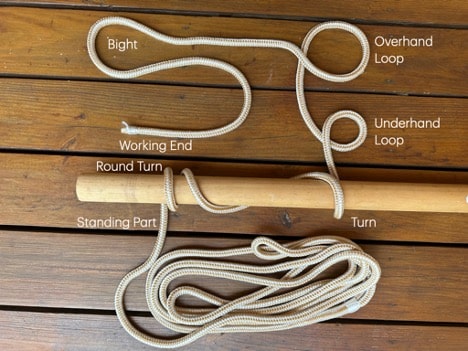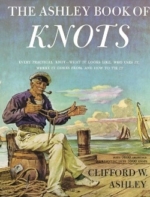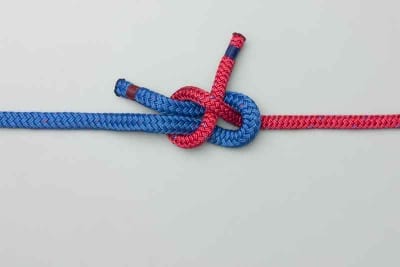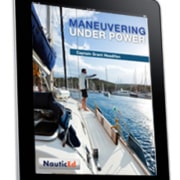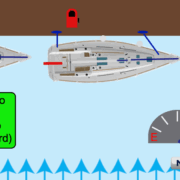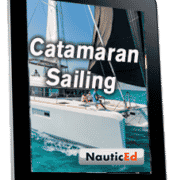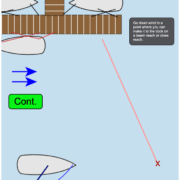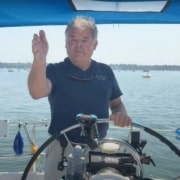Learn more about sail trim with either NauticEd’s FREE Basic Sail Trim Course for any aspiring sailor, or learn more comprehensive techniques with the Advanced Sail Trim online course.
9 Essential Knots Every Sailor Should Know
Bights, Bends, and Bitter Ends
by Bill Ibsen – NauticEd Sailing Instructor
Sailing knots are nothing short of mechanical genius. It’s not just that these knots hold fast; they can also be easily untied under load or once the load is eased. Unlike the overhand knots we tied in our sneakers as kids, which sometimes became nearly impossible to untie, many sailors’ knots can hold hundreds or even thousands of pounds of force yet remain relatively easy to untie.
Much like the elegant simplicity of a hairpin design, many of these 9 essential knots are as simple in form as possible. There’s a unique beauty in their design. I marvel at every correctly tied Trucker’s Hitch I create, both mechanically and aesthetically.
If you think my knot passion is a bit much, consider Clifford W. Ashley. His 1944 compilation, The Ashley Book of Knots, is esteemed as the definitive book on knots. He spent eleven years identifying and sketching 3,900 knots with 7,000 illustrations. If this article ropes in your interest, I highly recommend buying his humor-filled book, which details “every practical knot—what it looks like, who uses it, where it comes from, and how to tie it.”
For most readers, this article serves as a quick primer on the world of knots—some of which date back to ancient Egypt. If you’re skeptical, check out this photo I took at the Great Pyramids where archaeologists found a Pharaoh’s Nile River transport vessel sporting at least a square knot. We’re tying knots today as part of a long nautical tradition.
Understanding Knots and Lines
Lines have many fascinating features (who would have thought that something as simple as a line would have parts!). Check out the image below, and you’ll quickly grasp the concepts. But first, here are several quick tips:
- A “knot” is formed by tying a line to itself.
- A “hitch” makes a rope fast to another object.
- A “bend” joins two lines together.
- The “bitter end” of a line refers to the tail end of a line that fastens to the vessel but is often used to refer to the end of a line or its “working end.”
- A “bight” is not a “loop”—they are different. A bight becomes a loop when the two lines cross.
- Overhand loops are also called “traps” as they are often used to trap a bight, as in a Trucker’s Hitch.
Now, study this picture to get a tighter grasp of knot anatomy:
1. Cleat Hitch
My most frequently tied knot. Every time you pick up a mooring ball, you’ll tie two cleat hitches. You’ll also use it every time you secure your dinghy to a cleat on your moored yacht. That’s why the cleat hitch is #1 on my list.
Hey, did you know that cleats have discrete parts, too! They have “horns” connected to “shoulders” which is fairly self-explanatory if you just look at the overall shape.
Animated Knots offers two versions of cleat hitches: “dock lines” and “halyards.” NauticEd and other sailing schools teach the “halyard” version for docking. My friend, Captain Jeremy Elwell, confirms that his 36” sailboat remained securely tethered to the dock during 2018 Hurricane Michael’s category 5 winds (peaking at 160 mph) as it made landfall, thanks to the halyard version of the cleat hitch.
But if you’ve got a large boat (60’+), you may want to use Animated Knots Cleat Hitch (Docking Version) which substitutes lots of cute little figure-8’s in lieu of the “halyard” version’s final locking hitch, which indeed can get jammed under heavy loads like 40+ knot winds securing a 50’ catamaran with lots of windage. The many figure-8 wraps are super easy to untie under heavy load.
Tips:
- Always initiate the cleat hitch by wrapping the line around the FAR shoulder of the cleat relative to the direction of load.
- The finished product should look like “two roads under a bridge.”
- The input and output lines should enter/exit on opposite sides of the cleat. If they exit from the same side, try re-tying it.
2. Round Turn and Two Half Hitches
If the round turn and two-half hitch was a baseball player, it would be considered a “utility player” because it can play so many different positions very well. Use it to secure your dinghy painter to the dinghy dock. Use it to tie your fenders to the lifelines – because you don’t trust the clove hitch to hold fast your heavy fenders. Use it to stern-tie your catamaran to a big rock or tree ashore.
3. Bowline
A workhorse knot that does not slip or bind under load. Use a bowline to tie jib sheets to the jib clew, or to join two lines.
Etymology: The bowline has been in use for thousands of years, but the name first appeared in written English in 1627, when one John Smith called it the “Boling Knot.”
Engineering Note: Bowline knots break at about 70-75% of the line’s full strength. For example, a 3/4” nylon double braid dock line with a breaking strength of about 19,000 lbs. could take over 13,000 lbs. to break with a properly executed bowline knot.
Animated Knots notes that the bowlines’ “principal shortcoming is that it cannot be tied, or untied, when there is a load on the standing end. It should therefore be avoided when, for example, a mooring line may have to be released under load.”
A memorable method to tie a bowline is: “The squirrel goes through the hole, around the back of the tree, and back through the hole.”
Note: If you’ve got a long, relatively thick (e.g. 3/4” diameter) double-line dinghy painter, tying a “bowline on a bight” is a great way to quickly tie up to a dinghy dock or dock pylon, and not have to hassle with all the extra length of line. Just tie a normal bowline midway on the line using the double line as if it were just a single line.
More info at https://www.animatedknots.com/bowline-knot
Also, watch how to tie a Bowline on a Bight
4. Figure 8
This simple knot is used as a stopper knot on the end of a line, such as a jib sheet led through a fairlead or cam cleat. It prevents the line from whipping loose in a gust of wind, potentially smacking you or your crew in the face or elsewhere.
More info at https://www.animatedknots.com/figure-8-knot
5. Trucker’s Quick Release Hitch
Both sailors and truckers use this handy knot to cinch down a load. Sailors use it to secure a dinghy on the foredeck or for tying up a paddleboard to the lifelines. Its cinching power can create a 2:1 or even 3:1 purchase. Secure the hitch with two half hitches around the purchase.
6. Sheet Bend
Use this to join two lines of unequal or similar size. The thicker diameter line must be used for the simple bight.
More info at https://www.animatedknots.com/sheet-bend-knot
7. Clove Hitch
This hitch can be tied to a lifeline, pylon, or piling and is often used to tie smaller fenders to lifelines. It is quick to tie but not very reliable under load and can be hard to undo.
8. Square (or Reef) Knot
If your boat’s mainsail has a sail bag with shoelace-like ties, square knots are a tidy solution for securing the bag.
More info at https://www.animatedknots.com/square-knot
9. Rolling Hitch
Use this knot to apply a load to another line or a bar. It is useful for fixing an override in your winch by pulling out the jammed line below some of the wraps around the winch. The knot can slide down the line yet grip when pulled in the direction of the turns (i.e. the direction in which you’ll apply the load).
More info at https://www.animatedknots.com/rolling-hitch-knot
Conclusion +BONUS VID
Now, with these knots mastered, you’re ready to take on the high seas with confidence and flair. So, grab your captain’s hat, light up that pipe, and pull out your rum keg for a well-deserved seat. Practice these knots on the dock with an air of nautical wisdom (an eye-patch and parrot on your shoulder will only add to the mystique). If nothing else, you’ll become the dockside knot-tying legend, mesmerizing kids, and earning the respect (and possibly envy) of your fellow sailors. Who knows, maybe they’ll even start calling you the “Knotorious Captain”!
Happy knotting and smooth sailing!
Bonus content: Watch this Moorings charters dockmaster in Tahiti tie a fender to the lifelines in a clever way which allows the knot to be quickly released yet remains secure.
Thanks to NauticEd Instructor Bill Ibsen for writing this blog article.
###
Check out our full range of courses at NauticEd Sailing Courses
Learn something new, get certified, or just fill in knowledge gaps
LEARN SAIL TRIM
Learn more about sail trim with either NauticEd’s FREE Basic Sail Trim Course for any aspiring sailor, or learn more comprehensive techniques with the Advanced Sail Trim online course.


